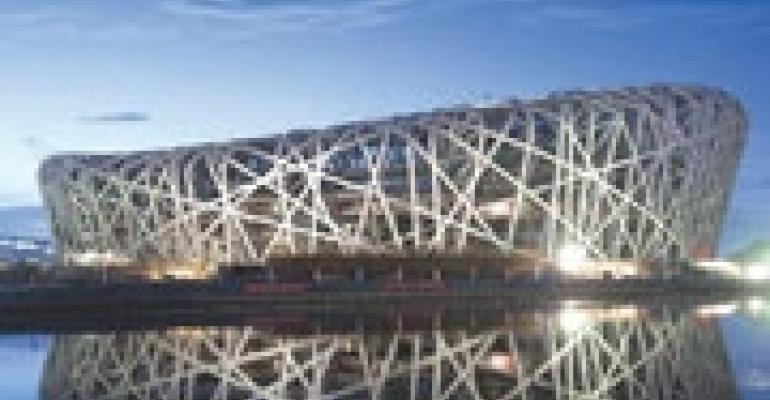
Transportation improvements completed in the Chinese capital and other host cities for the Olympic Games will generate even greater opportunities for development, according to commercial real estate experts.
“Beijing is in the midst of fundamental change as city planners begin to take a more realistic and proactive approach to orchestrating the city’s future development,” says Ben Christensen, head of research for Jones Lang LaSalle Beijing. “The Olympic Games have accelerated many of these changes.”
In a whitepaper, “The Greatest Olympic Legacy,” real estate service provider Jones Lang LaSalle contends that the expansion of Beijing’s subway system in preparation for the 2008 games will drive a fundamental shift in development patterns. Specifically, employment hubs are emerging along subway lines that will help to counteract traffic congestion caused by workers commuting by car between the suburban residential areas and employment clustered in the urban core.
The Olympics have served to accelerate and focus infrastructure growth that was already needed, experts say, and those improvements are ongoing. The Beijing subway network is poised to expand from the current length of 141.6 kilometers to 370 kilometers by 2015. “Greater connectivity and the creation of decentralized commercial hubs will facilitate continued economic and population growth in Beijing and create a myriad of opportunities for developers, investors and occupiers,” Christensen says.
The spectacular National Stadium, also affectionately known as the Bird’s Nest, and other Olympic venues will continue to host sporting events and fuel the retail and hospitality sectors of commercial real estate in the coming years, according to Chris Brooke, president and CEO of CB Richard Ellis in Greater China. Subways and roads, however, are the most influential improvements for economic development and commercial real estate to come from the Olympic Games, he says.
“This additional transport infrastructure has facilitated the implementation of new residential development areas, the emergence of new retail/commercial hubs as well as the creation of secondary office areas around new transportation hubs,” Brooke says.
Opportunities created by subway connections vary by neighborhood, according to Jones Lang LaSalle’s whitepaper. In the mature commercial district of Xidan, for example, transportation strengthens existing commercial development and will drive up property values. By contrast, the relatively undeveloped areas of Daxing and Chaoyang North Road will offer a spectrum of development opportunities including residential, retail, manufacturing and business parks.
The Olympics spurred some recent developments, but there are greater forces driving demand for commercial real estate in China. Growth in the gross domestic product (GDP) is the chief driver behind increasing demand for office space there, Brooke says. Beijing’s GDP of about $131 billion in 2007 was second among Chinese cities only to Shanghai’s GDP of $175 billion, and both cities posted annual GDP growth of about 12% last year.
As economic development moves north and west, the need for commercial space in those cities is increasing. “It’s leading to growth in demand for office space from both international and domestic companies, primarily focused on Beijing and Shanghai,” Brooke said in a recent webcast on China’s economy and real estate. “Now we’re also beginning to see increased depth of demand and increased space requirements for companies moving into second-tier cities, particularly in financial services, professional services, insurance and some of the sales and marketing areas.”
As a result of mushrooming demand, office rents are rising, too, with a 2.3% increase from the first to the second quarter in Beijing to approximately $30 per sq. meter per month, according to CBRE.
The central government’s efforts to slow the economy and the property market have brought about a self-induced credit crunch there, says Greg Penn, CBRE’s head of investment properties for Greater China. As a consequence, there is an increasing need for foreign capital to participate in joint ventures with China’s domestic real estate companies.
In the first half of 2008, transactions in Beijing included the $169.7 million acquisition of Yintai Center by Merrill Lynch and the $204.7 million purchase of a 65-unit multifamily project near the Olympic stadium by Pacific Alliance Group.
China’s development won’t slow down when the Olympics end, either. In fact, it would be a mistake to attribute the infrastructure gains completed in the months leading up to the games solely to Olympic fervor, according to Tim Johnson, a principal with the New York studio of global design firm NBBJ. The architecture firm has worked on projects in China since the mid-1990s.
“The amount of commercial space specifically built for the Olympics is miniscule compared to the overall development demand of commercial real estate in Beijing,” he says. "Therefore the overall market significantly overrides the Olympics as a driver.”
After the Olympics, Johnson expects China to wow the world again with its next big event, the Shanghai Expo, in 2010. “Expo 2010 Shanghai has already been underway,” he says. “And in typical Chinese fashion, it is monumental and will be complete ahead of time.”
There is also more growth ahead as population and employment gains spread to the nation’s emerging economic hubs. That will bring opportunities for developers and commercial real estate investors, says CBRE’s Brooke.
“Economic growth, rural to urban migration, increasing income levels and higher rates of consumer spending are all leading to continued growth in demand for residential, retail, office, hotel and logistics space,” says Brooke. “This demand is also being seen across a broader geographical area as the real estate markets in second- and third-tier cities continue to become more mature.”

